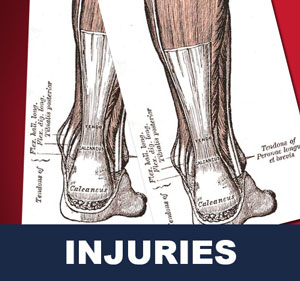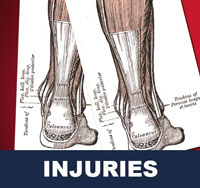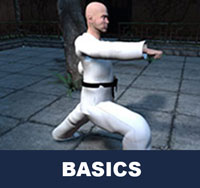Taekwondo 태권도Taekwondo Preschool
Promotion from one geup to the next can proceed rapidly in some schools, since schools often allow geup promotions every two, three, or four months. Students of geup rank learn the most basic techniques first, and then move on to more advanced techniques as they approach first dan. Many of the older and more traditional schools often take longer to allow students to test for higher ranks than newer, more contemporary schools, as they may not have the required testing intervals. View Taekwondo belt levels »

About Sprained Ankle
Sports injuries are injuries that occur in athletic activities. They can result from acute trauma, or from overuse of a particular body part. Please see a certified specialist or doctor for sports injuries. Proper guidance and instructions are needed from a certified Master Instructor ( 사범님 sabeomnim ) to ensure safe training.
A sprained ankle, also known as an ankle sprain, twisted ankle, rolled ankle, floppy ankle, ankle injury or ankle ligament injury, is a common medical condition where one or more of the ligaments of the ankle is torn or partially torn.
Signs and Symptoms
Knowing the symptoms that can be experienced with a sprain is important in determining that the injury is not really a break in the bone. When a sprain occurs, blood vessels will leak fluid into the tissue that surrounds the joint. White blood cells responsible for inflammation migrate to the area, and blood flow increases as well. Along with this inflammation, swelling from the fluid and pain is experienced. The nerves in the area become more sensitive when the injury is suffered, so pain is felt as throbbing and will worsen if there is pressure placed on the area. Warmth and redness are also seen as blood flow is increased. Also present is a decreased ability to move the joint, and difficulty using the affected leg.
Cause
Movements - especially twisting, turning, and rolling of the foot - are the primary cause of an ankle sprain.
The risk of a sprain is greatest during activities that involve explosive side-to-side motion, such as badminton, tennis or basketball. Sprained ankles can also occur during normal daily activities such as stepping off a curb or slipping on ice. Returning to activity before the ligaments have fully healed may cause them to heal in a stretched position, resulting in less stability at the ankle joint. This can lead to a condition known as Chronic Ankle Instability (CAI), and an increased risk of ankle sprains.
The following factors can contribute to an increased risk of ankle sprains:
- Weak muscles/tendons that cross the ankle joint, especially the muscles of the lower leg that cross the outside, or lateral aspect of the ankle joint (i.e. peroneal or fibular muscles);
- Weak or lax ligaments that join together the bones of the ankle joint – this can be hereditary or due to overstretching of ligaments as a result of repetitive ankle sprains;
- Inadequate joint proprioception (i.e. sense of joint position);
- Slow neuron muscular response to an off-balance position;
- Running on uneven surfaces;
- Shoes with inadequate heel support; and
- Wearing high-heeled shoes – due to the weak position of the ankle joint with an elevated heel, and a small base of support.
Ankle sprains occur usually through excessive stress on the ligaments of the ankle. This can be caused by excessive external rotation, inversion or eversion of the foot caused by an external force. When the foot is moved past its range of motion, the excess stress puts a strain on the ligaments. If the strain is great enough to the ligaments past the yield point, then the ligament becomes damaged, or sprained.
Inversion (lateral) ankle sprain
The most common type of ankle sprain occurs when the foot is inverted too much, affecting the lateral side of the foot. When this type of ankle sprain happens, the outer, or lateral, ligaments are stretched too much. The anterior talofibular ligament is one of the most commonly involved ligaments in this type of sprain. Approximately 70-85% of ankle sprains are inversion injuries.
When the ankle becomes inverted, the anterior talofibular and calcaneofibular ligaments are damaged. This is the most common ankle sprain.
Eversion (medial) ankle sprain
A less common type of ankle sprain is called an eversion injury, affecting the medial side of the foot. When this occurs, the medial, or deltoid, ligament is stretched too much.
High Ankle Sprain
A high ankle sprain is an injury to the large ligaments above the ankle that join together the two long bones of the lower leg, called the tibia and fibula. High ankle sprains commonly occur from a sudden and forceful outward twisting of the foot, which commonly occurs in contact and cutting sports such as football, rugby, ice hockey, roller derby, basketball, volleyball, lacrosse, softball, baseball, track, ultimate frisbee, gridiron, tennis and badminton and horse riding.
Treatment
Initial treatment commonly consists of rest, icing, compression and elevation (which is often referred to by the mnemonic RICE or sometimes PRICE with P being "protection"). These are recommended by physicians for the treatment of soft tissue damage, and sprained ankles are one of the most common soft tissue injuries. RICE helps limit the amount of swelling to the area, and "facilitates venous and lymphatic drainage".
Conservative Measures
If the ankle is not swollen, if it just hurts to walk on and has limited mobilization, it is generally recommended that the injured person wears an orthopedic walking boot for two weeks and is on crutches for the first week at least. Ice is often used to reduce swelling in cycles of 20–30 minutes on and 20–30 minutes off. Icing an ankle too long can cause cold injuries, indicated if the area turns white.
In uncomplicated lateral ankle sprains, swelling of the soft tissue can be prevented with compression around both malleoli, elevation of the injured ankle higher than the heart, and pain-free exercises.
An orthopedic walking boot is often used for the treatment of a sprained ankle injury. Braces and crutches are also used to help alleviate the pain so the injured ankle can heal as quickly and painlessly as possible.
Although found to be less effective than casts, compression bandages are used to provide support and compression for sprained ankles. Wrapping is started at the ball of the foot and slowly continued up to the base of the calf muscle, pushing the swelling up toward the center of the body so that it does not gather in the foot.

Rehabilitation
Many different types of rehabilitation exercises can be done to aid an ankle sprain regardless of the severity of the injury. The purpose of rehabilitation gives the ability for the ankle to regain strength and flexibility. A sprained ankle becomes swollen due to the increased amount of edema within the tissue, since this physiological effect is the foundation of the pain the decline of edema is the main goal during the beginning of rehabilitation. This can be done instantly by implementing the RICE mechanism which is resting the ankle, applying ice, compressing, and elevating it. The emphasis of the first week of rehabilitation should be on protecting the ankle to avoid further damage. As the healing progresses, stress can be applied by different mechanisms until the ankle is fully recovered. The key to a fast recovery is to implement all the different types of ankle sprain exercises so that the range of motion will increase while the pain is decreasing.
In cases where the ankle does not heal in an appropriate amount of time, other exercises need to be implemented so that strength and flexibility can be regained. Physical therapists assign different types of ankle sprain exercises that deal with ankle flexibility, strengthening, balance, and agility. If an ankle sprain does not heal properly, the joint may become unstable and may lead to chronic pain. Receiving proper treatment and performing exercises that promote ankle function is important to strengthen the ankle and prevent further injury.
Ankle Exercises
To prevent sprains or re-injury from occurring, strengthening and stretching exercises should be done through a full range of ankle motion. To improve ankle mobility, ankle circles can be performed by extending the legs in front of the body and then moving the foot up and down, side to side, or rotating the foot in a circle. Another common exercise to improve mobility as well as proprioception is to use the toes to draw the letters of the alphabet in the air. Most importantly, the lateral aspect of the ankle joint should be strengthened with eversion exercises (i.e. underside of the foot is turned outward against resistance) to improve lateral ankle stability. Stretching is also an important component of a strengthening program, to help maintain joint flexibility.
Balance and stability training are especially important to retrain the ankle muscles to work together to support the joint. This includes exercises that are performed by standing on one foot and using the injured ankle to lift the body onto its toes. To further enhance balance and stability, exercise devices such as the wobble board can be used, progressing from double-leg to single-leg stance, first with eyes open and then with eyes closed, for enhanced effectiveness.
Flexibility Exercises
Example of a flexibility exercise is a towel stretch and writing the alphabet with toes which will increase the range of motion.
Strengthening Exercises
Ankle strengthening exercises are step ups and walking on toes which will strengthen the muscles around the swollen area.
Balances Exercises
Balance exercises include the use of a wobble board, which helps the whole body function to maintain balance. The use of wobble boards has been shown to produce significantly positive results in gaining proper balance.
Agility Exercises
Plyometrics exercises such as squat jumps and power skipping should NOT be implemented until the ankle has regained full agility.
Other strategies that can be used to prevent ankle injury include:
- Ensure proper warm-up prior to stretching and activity;
- When running, choose level surfaces and avoid rocks or holes;
- Ensure that shoes have adequate heel support;
- If high-heeled shoes are worn, ensure that heels are no more than 2 inches in height, and avoid heels with a narrow base.

Related Articles
Sports injuries are injuries that occur in athletic activities such as in taekwondo. They can result from acute trauma, or from overuse of a particular body part. Collisions with the ground, objects, and other practitioners are common, and unexpected dynamic forces on limbs and joints can cause injury. View Sport Injuries »
- Achilles Tendon - the Achilles tendon is the most commonly injured tendon. Rupture can occur while performing actions requiring explosive acceleration, such as pushing off or jumping.
- Bone Fracture - a bone fracture is a medical condition in which there is a break in the continuity of the bone. A bone fracture can be the result of high force impact or stress, or a minimal trauma injury as a result of certain medical conditions that weaken the bones, such as osteoporosis, bone cancer, or osteogenesis imperfecta.
- Pulled Hamstring - defined as an excessive stretch or tear of muscle fibers and related tissues. Hamstring injuries are common in athletes participating in many sports and are very difficult to treat and rehabilitate.
- Sprain - damage to one or more ligaments in a joint, often caused by trauma or the joint being taken beyond its functional range of motion. The severity of sprain ranges from a minor injury which resolves in a few days to a major rupture of one or more ligaments requiring surgical fixation and a period of immobilisation.
- Sprained Ankle - also known as an ankle sprain, twisted ankle, rolled ankle, floppy ankle, ankle injury or ankle ligament injury, is a common medical condition where one or more of the ligaments of the ankle is torn or partially torn.
- Strain - an injury to a muscle in which the muscle fibers tear as a result of overstretching. A strain is also colloquially known as a pulled muscle. The equivalent injury to a ligament is a sprain.

Taekwondo Basics
Here is where you can learn more about Taekwondo 태권도. Knowing the fundamental basics is very important for your learning path as you build your skills and knowledge. There are certain rules that need to be followed to show respect to the master ( 사범님 sabeomnim ), the instructors ( 교사님 gyosannim ), other practitioners and to the martial arts. They vary between schools but many have similar rules and guidelines. For more information View Taekwondo Basics »
Please see a certified specialist or doctor for sports injuries. The article provided on this page is information that is widely available on Wikipedia article "Sprained Ankle". Risk of injury can be reduced by completing an effective warm up consisting of a heart raiser to get your pulse up, followed by sport specific dynamic stretches (stretches whilst moving). Please follow the guidance of a certified Master Instructor or trainer when doing sports related activities.
RESOURCES
This article uses material from the Wikipedia article "Sprained Ankle", which is released under the Creative Commons Attribution-Share-Alike License 3.0.


















